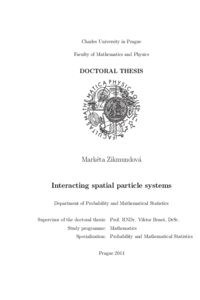Interacting spatial particle systems
Interagující prostorové systémy částic
rigorous thesis (RECOGNIZED)

View/
Permanent link
http://hdl.handle.net/20.500.11956/192524Identifiers
Study Information System: 271701
Collections
- Kvalifikační práce [11326]
Author
Advisor
Faculty / Institute
Faculty of Mathematics and Physics
Discipline
Probability, Mathematical Statistics and Econometrics
Department
Department of Probability and Mathematical Statistics
Date of defense
5. 9. 2024
Publisher
Univerzita Karlova, Matematicko-fyzikální fakultaLanguage
English
Grade
Recognized
Keywords (Czech)
Boolovský model|proces interagujících částic|U−statistiky|exponenciální rodina rozdělení|germ-grain model|interakce|Markovská vlastnost|bodový process|náhodná uzavřená množina|Markov chain Monte CarloKeywords (English)
Boolean model|process with interacting particles|U−statistics|exponential family|germ-grain model|interaction|Markov properties|point process|random closed set|Markov chain Monte CarloPráce se zabývá několika typy náhodných sjednocení interagujících částic. Jsou definovány procesy interagujících úseček v R2 a interagujících destiček v R3 jako modely s hustotou vzhledem k Poissonovu procesu. Jsou odvozeny vzorce pro geometrické charakteristiky těchto modelů a je zkoumáno limitní chování pro intenzitu jdoucí do nekonečna. Pro časové rozšíření modelu je uveden simulační algo- ritmus a v rámci simulační studie jsou porovnávány různé druhy odhadů parametrů hustoty p, zejména se zaměřením na sekvenční Monte Carlo metody. 1
Several kinds of random union of interacting particles is studied. We define line segment pro- cess of interacting particles in R2 and process of interacting surfaces in R3 as the models with density function p with respect to some Poisson point process. The formulas for moments of the geometrical characteristics of these models are derived and the limit behaviour when the intensity tends to infinity is investigated. For time extension of such models a simulation algorithm is developed. Various estimations of parameters of density p, among them those based on sequential Monte Carlo, are studied and compare in a simulation study.
